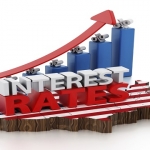 From the moment the Fed began their Quantitative Easing policy till today investors have asked me the same question.
From the moment the Fed began their Quantitative Easing policy till today investors have asked me the same question.
“When are interest rates going to rise and how high do you think they will go?”
Most economists expect 2015 to be the year the Fed raises interest rates. If nothing changes from where we are today (U.S. economy growing, unemployment rate in decline, and moderate inflation), then short-term rates should go up sometime next year.
One key question remains. Why haven’t rates gone up already? That question has confounded investors all year. And the answer could provide clues about what the Fed will do in 2015. For 2014 U.S. economic growth has been anything but steady. Severe winter weather put a damper on economic activity in the first quarter, sending GDP growth negative (–2.1%) for the first time since 2009. Second quarter growth was significantly better, rising 4.6% as consumer spending picked up.
Most Economists predict better growth ahead. They point out that the U.S. economy is on firm footing and heading for annualized Gross Domestic Product (GDP) growth of 3% to 3.5% next year. That is due to several factors, including:
• Improving fiscal conditions at state and local governments
• A strengthening labor market and a declining federal budget deficit
• A pick-up in business investment and rising corporate earnings
The outlook for American jobs has also improved dramatically. The U.S. unemployment rate has declined from 10% at the height of the financial crisis to 5.9% in September, its lowest level since July 2008. Meanwhile, despite worries that several years of ultra-low interest rates and quantitative easing would produce alarmingly high inflation, consumer prices actually fell in August, largely due to a decline in gasoline prices. With an annualized inflation rate of 1.7%, U.S. consumer price increases are well below the Fed’s target rate of 2%, suggesting that inflation remains in check. Consequently, there is little pressure for the Fed to quickly raise rates.
Of course we all know rates will eventually rise, but as I stated previously the key questions for investors are ‘when?’ and ‘how fast?’ Half of the economists I follow think it will take longer than most people think and that it will be a very slow process. One reason for their extended outlook, is that many important factors are not within the Fed’s control. Namely central banks in Europe, Japan and China. They are going in the opposite direction of the Fed and that’s not likely to change anytime soon.
Their stimulus measures put tremendous pressure on global bond yields, including U.S. Treasuries, which ironically have become even more attractive to investors because of their relatively high yields.
German 10-year bond yields recently fell below 1%, and comparable Japanese bonds hover around 0.5%. That makes the yield on 10-year Treasuries look downright generous. Fully 45% of government bonds issued around the world are yielding less than 1%, according to a report by Bank of America.
Another major factor weighing on interest rates this year is what investors sometimes call the “fear trade.” Demand for perceived safe-haven assets, such as Treasuries and high-grade corporate bonds, soars whenever geopolitical tensions flare up. With the U.S. slowly reducing its role as world policeman, 2014 has had no shortage of armed disputes. Major events include: Russia’s invasion of Ukrainian territory in the Crimea, renewed fighting between Israel and Hamas in the Gaza Strip, and the emergence of ISIS in Iraq and Syria which is seeking to overrun large portions of both countries.
Over the long term, however, rising interest rates — particularly in a market starved for yield —are not necessarily a bad thing. In this environment, existing bonds will lose some value in the short term, but newly issued bonds will offer better yields and, ultimately, higher total return opportunities. Especially among short-dated bonds that pay almost nothing today. As the financial markets enter a new year, investors should keep in mind why they hold bonds in the first place: to preserve capital and provide income in a diversified portfolio. With U.S. equity valuations arguably at lofty levels, the importance of owning low-risk, non-correlated assets becomes even more evident.
To learn more about Guy Conger, view his Paladin Registry profile.
Other posts from Guy Conger
Market Volatility Is Nothing New
I’m tasked with writing financial articles for many internet sites and even a few publications. I find this...
Some Words of Wisdom to Investors
Dear Fellow Investor, the events of the last couple of weeks gave me the idea of providing a...
Interest Rates Rise as Fed Decides
After waiting seemingly forever, the Fed finally raised short-term interest rates last week by 25 basis points, or...




